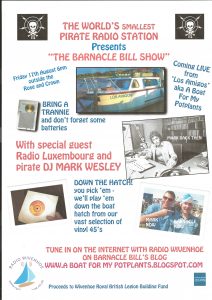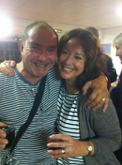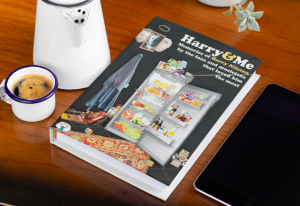HARRY & ME
(otherwise known as the ‘ABOUT’ page)
See how I eventually fulfilled a dream to write a book about my music hero, Harry Nilsson.
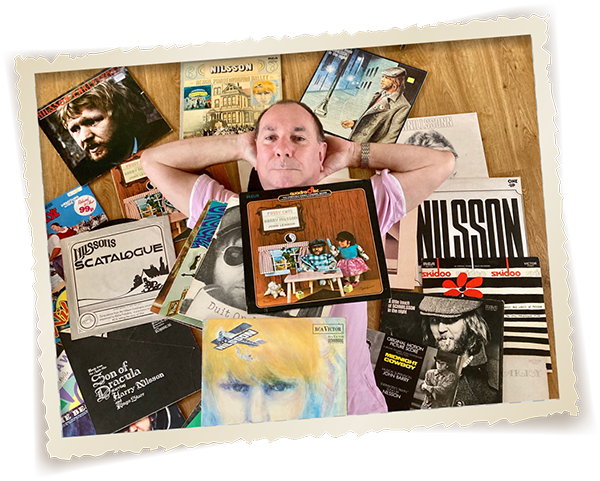
HARRY WHO?
INTRODUCING NILSSON, AND HOW HE AND HIS MUSIC HELPED SHAPE MY LIFE, SO FAR.
If you want to skip all the stuff about me, just click ‘HARRY & ME’ and save yourself an awful lot of time by going straight to the bit about the book.
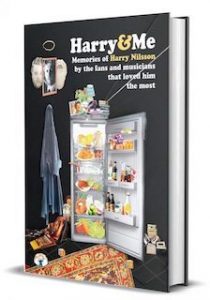 ‘HARRY & ME’ – co-authored with David Roberts, formerly editor of Guinness Book of Hit Singles and writer of Rock Atlas, Rock Atlas USA, and biographies of Stephen Stills and Paul Rodgers.
‘HARRY & ME’ – co-authored with David Roberts, formerly editor of Guinness Book of Hit Singles and writer of Rock Atlas, Rock Atlas USA, and biographies of Stephen Stills and Paul Rodgers.
Harry NILSSON, (the American singer-songwriter who had massive hits in the late ’60s and early ’70s with Everybody’s Talkin’ and Without You),
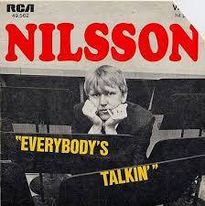 was also great pals with all of The Beatles, particularly Ringo Starr and John Lennon.
was also great pals with all of The Beatles, particularly Ringo Starr and John Lennon.
PROLOGUE … MEETING MUM
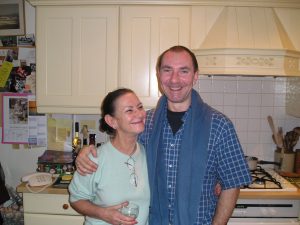
I can trace my early Nilsson influence back to when I first met my mother and my sister Jane, at my age of 12. I know that sounds a bit odd, but you see, when I was two and my sister was six months, our parents Jackie and Robert went their separate ways, accompanied by one sibling each – Jane with Mum, and me with Dad. We would be brought up in vastly different environments; Jane grew up with Mum who married Gerry, a man in the exciting world of TV, commercials and film, such as Black Beauty, London’s Burning, the Andrex puppy and Cadbury’s chocolates TV ads.
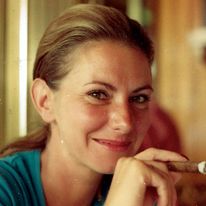 In fact it was Mum’s hand used when the voiceover said “And all because the Lady loves Milk Tray.”
In fact it was Mum’s hand used when the voiceover said “And all because the Lady loves Milk Tray.”
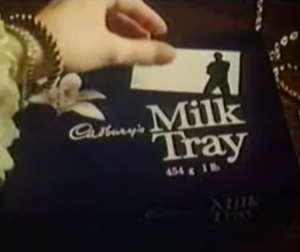
Dad remarried when I was seven, but I wasn’t to meet my mum or sister Jane again until I reached my early teenage years, when at the age of 12 I was reunited with them in their big country house ‘Chequers’, complete with swimming pool, stables, horses, tennis lawn and Bentley car.
I also met my two half-sisters Fiona and Emma, who were 5 and 3 at the time. Immediately my heart warmed and I couldn’t wait to get to know them all better.

My wish was granted. It had been agreed that I would spend every other weekend at Chequers, and I was to join them all for the entire Summer holidays, being driven in a Bentley through France to be in their apartment on the Côte d’Azure.
CHAPTER ONE …DISCOVERING NILSSON
But what has meeting my mum got to do with Harry Nilsson?
Well, I returned to France a couple of years later with Mum, step-dad Gerry, sisters Jane, Fiona and Emma – and by then my new half-brother Jeremy. One of Mum’s favourite records was ‘Nilsson Schmilsson’ (Harry’s most commercially successful album, released November 1971 that reached Number One the following year). It was repeatedly played on their Braun radiogram during another all summer-long holiday.

Nilsson Schmilsson, with its haunting melodies, up-beat charismatic songs, the soaring Without You, and of course that song that I always leapt up to move the needle across to the next track, Jump Into The Fire. It was just so loud, rock-oriented, and went on seemingly forever, destroying the peaceful ambiance. Now I love it.
I knew nothing about this unusual singer. Was it a man on his own? A group? Had he done other records?
I had to rely on making visits to record shops, to libraries, to look up music encyclopaedia, to read the music press of the day; Sounds, NME and Melody Maker. I soon learned that ‘Harry‘ Nilsson was American, and he’d worked with every individual member of The Beatles.
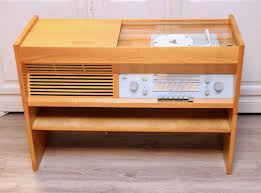
Before too long I’d managed to buy up his back-catalogue of albums, eagerly getting to know every track that had been released prior to ‘Nilsson Schmilsson’.
And it was all because the lady (Mum) loved playing Nilsson Schmilsson LP over and over on the Braun radiogram in France. My Nilsson infatuation would go on to this day.
I wanted better sound quality than Dad’s radiogram on which he played his Chopin, Andy Williams, Matt Monro, and even Telly Savalas, but all I could afford was a BSR deck in kit form, a basic Teleton amp and some 2nd-hand Wharfedales. But even so… WOW! the sound was fantastic.
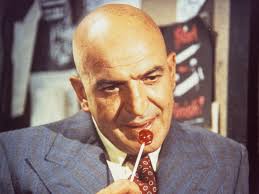
One day I tried Dad’s Telly Savalas record. It was awful! But Kojak’s deep vocals proved to be good for testing stereo equipment. On that LP was the song Without Her that I actually quite liked. Nice lyrics, I thought. ‘Written by H. Nilsson’, it said on the credits. Could that be the same ‘Nilsson’? It turned out that it was, and I realised that Harry had written songs for others. Coincidentally, in later years he wrote and recorded the song Kojak Columbo.
I was 19, and had caught the hifi bug big-time, constantly changing my stereo equipment in search of that perfect, but forever elusive sound. ‘Nilsson Schmilsson’, ‘Nilsson Sings Newman’, ‘Harry’, ‘The Point’ – these were my benchmark albums that I’d use to test my latest component, always seeking that ‘WOW!’ sound again.
My fascination with Nilsson coincided with my ability to drive. I drove my deliciously terrible Citroën GS through London to the Mermaid Theatre where a season of Nilsson’s ‘The Point’ was being performed, listening to Nilsson tapes on the atrocious in-car player.
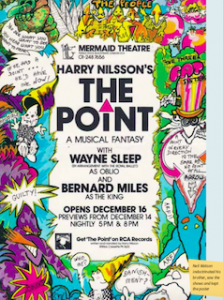
It would have to go.
Thanks to my mother, and then Nilsson, I had turned into an audiophile. Little did I know that Nilsson and hi-fi would play a role in my future career.
CHAPTER THREE … CYCLING AMERICA

I had developed a keen interest in cycling, and decided to cycle across Nilsson’s country from west to east. The thought of visiting those massive record stores was just so exciting.
I was in a boring job, and had received an insurance payout of £500 for a car crash not my fault – more money than I’d ever had in one lump sum. I bought a Freddy Laker Airlines ticket, prepared my bike that my Mum had bought be for my 13th birthday, and I fitted a handlebar-radio to keep me company.
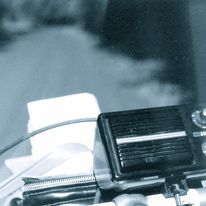
On 27th April 1981, the day after my 21st birthday, I boarded the plane bound for Los Angeles, with my dismantled bike boxed and stowed in the hold. After going through Immigration and reassembling my bike in a corner of LAX’s foyer, excited but petrified, I exited the sliding doors that led to the hot and humid street outside, and asked the nearest passer-by “Excuse me, which way is New York?”
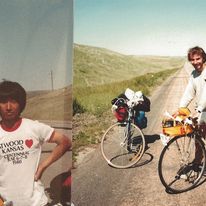 For the next ten weeks, my handlebar-radio, provided music wherever I went, including the six-day stretch across the plains of Kansas, when I met a Japanese guy, Yushi (later to become the main character in my 2nd novel), going the other way on his bike. Occasionally I’d hear Nilsson’s Everybody’s Talkin’, but more often the stations would play the hits of the time on rotation; among them Being With You by Smokey Robinson, All Those Years Ago by George Harrison, and Bette Davis Eyes by Kim Carnes.
For the next ten weeks, my handlebar-radio, provided music wherever I went, including the six-day stretch across the plains of Kansas, when I met a Japanese guy, Yushi (later to become the main character in my 2nd novel), going the other way on his bike. Occasionally I’d hear Nilsson’s Everybody’s Talkin’, but more often the stations would play the hits of the time on rotation; among them Being With You by Smokey Robinson, All Those Years Ago by George Harrison, and Bette Davis Eyes by Kim Carnes.
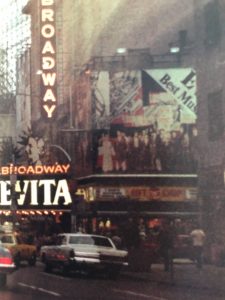
Sadly, my money ran out, and I skipped the record stores of New York in favour of a quick car ride across town, via Broadway, to the airport. I’ve always regretted not going to Brooklyn, Harry Nilsson’s birthplace. One day I will return.
CHAPTER FOUR …PROPER JOBS

Back in London, I needed work.
I got a couple of ‘extras’ jobs, including Cadbury’s Creme Eggs, in which I had to be dressed as a Victorian gentleman, arm in arm with a lady (played by my sister Fiona). That was fun!
With the cash I’d earned, I began a small business setting up exhibition stands at Wembley and the NEC.
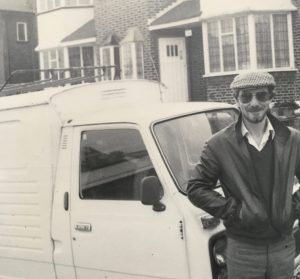
It cost me dearly to keep hiring vans, so eventually I bought my own – a Honda Acty for £600. It was small but perfectly formed, and thingswere looking up, and I was enjoying self-employment, until one day I saw an ad for German electronics giant Grundig looking for an ‘exhibitions assistant’. I applied and was offered the job, based up in the Midlands.
 For the next three years, I happily went about the country in their van, setting up TVs, videos and superb hifi equipment at their trade shows, until I became their London sales rep, and discovered I was quite good at it.
For the next three years, I happily went about the country in their van, setting up TVs, videos and superb hifi equipment at their trade shows, until I became their London sales rep, and discovered I was quite good at it.
 That led to becoming Sales Manager for their car audio division. Sometimes I’d drive Porsches round a track to test the in-car systems, playing Jump In To The Fire nice and loud. Fantastic! – and I was being paid for it!
That led to becoming Sales Manager for their car audio division. Sometimes I’d drive Porsches round a track to test the in-car systems, playing Jump In To The Fire nice and loud. Fantastic! – and I was being paid for it!
After 10 glorious years at Grundig, I moved to Swiss company Roadstar, a lovely but much smaller company. After 4 years the UK division closed and I was offered a redundancy package, far greater than I could have wished for.
What should I do with all that money? “I know – I’ll start up a magazine for other sales people like me, and I’ll call it CoatHanger.” (See the BOOKS AND WRITING page and check out COATHANGER MAGAZINE.
CHAPTER FIVE … PUBLISHING TYCOON
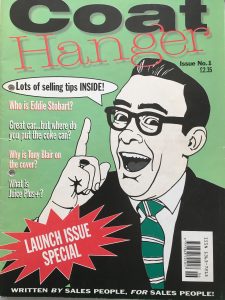
The concept behind CoatHanger magazine was simple – it was a lifestyle comic for sales reps. They’d hang their jacket on a coathanger in the rear window, and off they’d go in pursuit of their next sale. Just like I used to do.
The regular feature ‘What I Sold Today’ included one rep who sold pig-semen for a living!
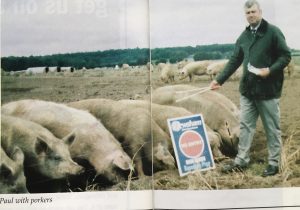
CoatHanger was also about what suits and ties to wear, what jokes to tell, what coffee to drink. But the best thing for me was to write about what music to play on the stereo while driving from one appointment to the next. This was my golden opportunity to educate the readers about Nilsson.
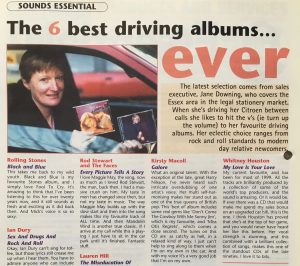
Cars also played a significant part of CoatHanger’s content, and before long I was being asked to review new cars at their press launches. Flying off by private jet to test-drive the new Fiesta, for example, around Barcelona courtesy of Ford wasn’t a bad gig to have, along with ‘real’ motoring correspondents from the Times or the Telegraph.
I was perplexed. “How did I get here?” I asked myself. I still to this day don’t know – I was only a sales rep writing about Harry Nilsson in a magazine.
Head over HERE to read more about the finest, and perhaps only, magazine for sales reps.
CHAPTER SIX … HARRYFEST ’98
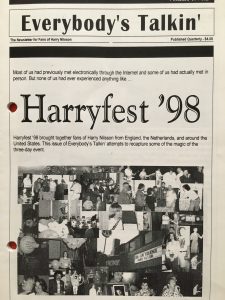
Publishers use Apple Macs don’t they?
I stared blankly at my newly purchased Apple Mackintosh, not knowing what to do. I cautiously typed ‘H A R R Y N I L S S O N’. Lots of information popped up, including the news that there was a fan magazine published by a Roger Smith in Florida. Amazed, I reached for the phone and rang the international number.
Roger answered and he informed me about the world’s first ever ‘HarryFest’ in Los Angeles the following year. I knew I would HAVE to go.

So, in 1998 I arrived at the home of another ‘superfan’, the actor Curtis Armstrong (‘Moonlighting’, ‘Ray’), where he hosted the first ever gathering of Nilsson fans, in his Hollywood Hills house overlooking LA, like in the movies.
The following day we all met again at a hotel for the official HarryFest, listening to presentations by people who knew Harry well, and it was here that I met Zak, Harry Nilsson’s eldest son.
That evening there was a Nilsson tribute concert at the Roxy Club on Sunset Boulevard. I felt like I was in some surreal dream, especially because Harry’s friends Bob and his wife Minako (who played Rosie in M*A*S*H) drove me there.
The show comprised different artists performing Nilsson compositions, with some of Harry’s children also in the audience.
The following day, Sunday, Zak Nilsson invited me to accompany him to the Valley Oakes Memorial Park see his dad’s resting place, and it was there that I met Una (Harry’s widow).
 After chatting a while, Zak invited me back to his house for a game of swimming-pool volley-ball. An hour later we were throwing a ball to each other in the water. After drying off, he showed me his music room, complete with photos of his dad with John Lennon, and with Ringo Starr. Zak handed me the actual Grammy award that Harry had won for Male Pop Vocal Performance for Everybody’s Talkin’.
After chatting a while, Zak invited me back to his house for a game of swimming-pool volley-ball. An hour later we were throwing a ball to each other in the water. After drying off, he showed me his music room, complete with photos of his dad with John Lennon, and with Ringo Starr. Zak handed me the actual Grammy award that Harry had won for Male Pop Vocal Performance for Everybody’s Talkin’. 
I was also allowed to listen to Harry’s last ever recordings he made before his death in 1994, his demos for a new album with working title ‘Papa’s Got A Brown New Robe’. Only a handful of people had heard it as it was closely kept under wraps by the Nilsson Estate – and now I was one of the privileged few.
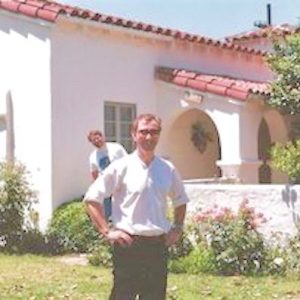 The following morning I packed my bag, got a taxi back to LAX, boarded the plane, fell asleep and awoke as we were approaching Heathrow. Soon after I was on the tube to Southgate, and then I was home.
The following morning I packed my bag, got a taxi back to LAX, boarded the plane, fell asleep and awoke as we were approaching Heathrow. Soon after I was on the tube to Southgate, and then I was home.
The following day I went back to work unable to believe the weekend had happened.
CHAPTER SEVEN … MUSIC MOGUL
At the age of 44 I was getting remarried. Jane and I booked Joanna Eden, a local musician, to play at our wedding reception in Saffron Walden at the local hotel. She was outstanding.
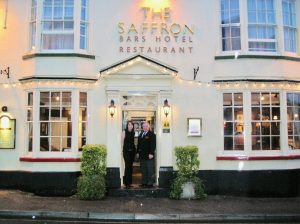
A few weeks later we were all at the hotel again for an evening of jazz when Joanna sang a couple of songs, bringing the house down.
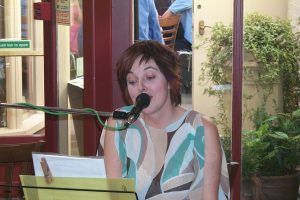 I knew in that instance that I wanted to try to help her career, and I became her ‘manager’.
I knew in that instance that I wanted to try to help her career, and I became her ‘manager’.
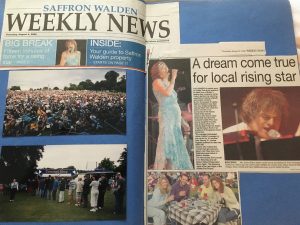 Luck was on my side and I managed to get her a gig at Jamie Cullum’s large open-air concert, playing to an audience of thousands. Also, thanks to my neighbour and ex-Radio Luxembourg DJ and film-maker Mark Wesley, he agreed to make a video of Jo’s single, Singing Out for free!
Luck was on my side and I managed to get her a gig at Jamie Cullum’s large open-air concert, playing to an audience of thousands. Also, thanks to my neighbour and ex-Radio Luxembourg DJ and film-maker Mark Wesley, he agreed to make a video of Jo’s single, Singing Out for free!
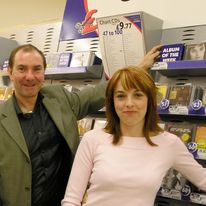
We applied for a £5,000 Arts Council grant to promote it – and we got it.
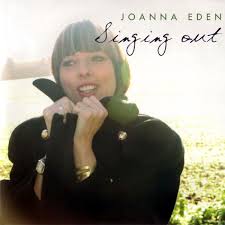
I leapt at the chance to interview a number of PR specialists who could get us more radio airplay, and that was when another Nilsson connection occurred… See CHAPTER 8 MY NILSSON CD.
Joanna has since written and recorded a remarkable song to accompany my novel, MUDDY WATER. You can listen to it HERE.
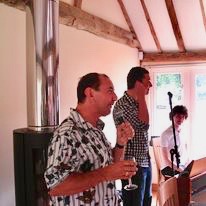
The Saffron Hotel owner Cliff backed me to form a music management company to represent Joanna, and a teenage Sam Smith, who was also Joanna’s singing student at the time.
When I first heard Sam sing, I knew that he was destined for fame and fortune, and I wanted to play a part of his introduction to the world.
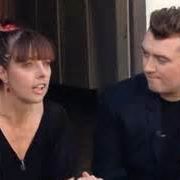
I took a demo recording of his to Sony, and they ask me to return with two professionally-recorded songs. My old pal, music producer and guitarist Jay Stapley readily agreed to record the songs in his north London studio, and everything was coming together nicely…
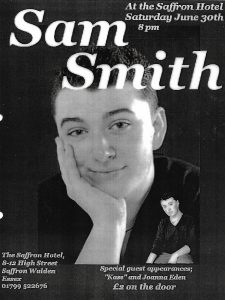 … until another management company wanted part of the Sam Smith action. There was only room for one and it wasn’t me! We amicably parted company.
… until another management company wanted part of the Sam Smith action. There was only room for one and it wasn’t me! We amicably parted company.
I was ‘that close’ to becoming a music mogul!
CHAPTER EIGHT … MY NILSSON CD

It’s funny how one thing leads to another.
Thanks to Joanna Eden’s Arts Council Grant I unexpectedly found myself being asked to select my own personal playlist for the whole world to hear.
One of the candidates to become our PR specialist, Alan Robinson, was also a consultant to Sony Music, and his job was to compile a ‘Best-Of’ collection of Nilsson songs. He recalled from the time we met that I knew a lot about Harry’s music.
Late one evening he phoned me. Would I choose 36 songs that chronologically represented Nilsson’s catalogue for a Sony double CD? Of course I would! But the deadline was the following morning.
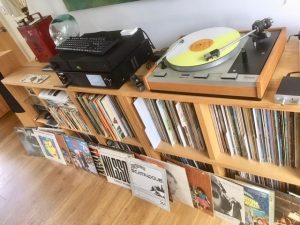
I stayed up all night and delivered my choices. It was an unpaid labour of love that in fact I would have happily paid for the privilege of doing.
But how could I be sure that the selected tracks was my selection when the CD came out?
I had an idea: for my 36th track, I included Harry’s version of John Lennon’s Isolation. It had never been released commercially, but I knew of its existence. If Sony included it there would be no doubt that they were using my list and nobody else’s.
‘ONE – THE BEST OF NILSSON’ was released on 26th November 2007. Trembling with excitement, my eyes darted down to the last track, and there it was: Isolation. And all the other tracks were in my suggested order. This was without doubt ‘my’ CD! And I received an acknowledgement from Alan:
“The author is indebted to Neil Watson for his exemplary assistance in this compilation.” I couldn’t have been more proud.
CHAPTER NINE … BARNACLE BILL
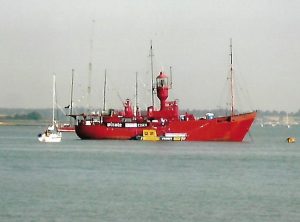
In 2007, Mark Wesley, the ex-Radio Luxembourg DJ who produced Joanna Eden’s promo video, and I had become mates. He’d been asked to present a show for BBC Radio Essex, celebrating the off-coast pirate radio days of the 1960s, and it would be broadcast from the LV18 lightship, moored off the Harwich coast. The LV18 was one of the original pirate radio vessels, and was also featured in the film The Boat That Rocked.
Mark got the necessary permissions for me to come along, and he told me that I could be ‘Barnacle Bill’, reading out dedications and that sort of thing. I was ecstatic.
 All music played had to be from 1968 or earlier, and I made it my personal challenge to slip a Nilsson song in. I chose a relatively obscure track, There Will Never Be that had a distinct sixties sound.
All music played had to be from 1968 or earlier, and I made it my personal challenge to slip a Nilsson song in. I chose a relatively obscure track, There Will Never Be that had a distinct sixties sound.
The big day came, and we carefully climbed the ladder to embark the ship.
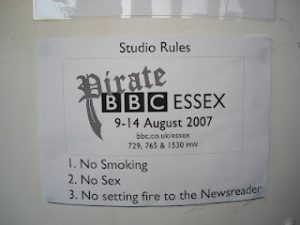 I’m not usually lost for words, but on this occasion I was. There, standing on deck just a few feet in front of me was the legendary DJ Johnny Walker, now sadly passed. I’d been an admirer of his for many years, listening to him on his popular Radio 2 Drive-Time show.
I’m not usually lost for words, but on this occasion I was. There, standing on deck just a few feet in front of me was the legendary DJ Johnny Walker, now sadly passed. I’d been an admirer of his for many years, listening to him on his popular Radio 2 Drive-Time show.
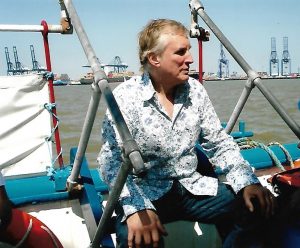
I remembered some years earlier I’d interviewed his travel news presenter Sally ‘Traffic’ Boazman for COATHANGER magazine, and Johhny had graciously given our magazine several valuable plugs on-air.
I plucked up the courage to talk to him, and reminded him of that time.
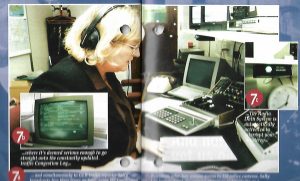
I also knew he was a Nilsson fan, having once listened to him playing the entire side of Harry’s ‘The Point‘ album on his show.
I did get There Will Never Be played on the ‘Mark Wesley with Barnacle Bill’ show, and Johnny was listening to us below deck.
On our way back to shore, Johnny was on the small ferry with us.
“Ah, Nilsson. He was a one-off,” he said.
The sun had shone that day. I’d met my radio hero, and played a Nilsson song on the radio. I was buzzing from adrenaline all the way home.
CHAPTER TEN … PIRATE RADIO
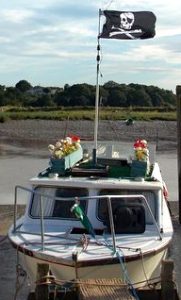
I called it “The World’s Smallest Pirate Radio Station.”
We had moved to Wivenhoe and I’d been given an old boat to renovate. Once it was brought to its resting place on the Quay outside the pub, I had an idea to turn the BOAT FOR MY POTPLANTS into a radio station for one day.
This time it would be my show, with Mark Wesley being my Barnacle Bill.
When I first invited him, he rolled his eyes and agreed to at least have a think about it.
The concept was to use a small FM transmitter you can get for playing your phone through a car stereo, and to broadcast the show from inside the boat to the good folks of Wivenhoe, eagerly sitting on the quayside all of 30 feet away, tuning into their own transistor radios that they’d brought along. My friend Jerry Davis from Wivenhoe Radio also had the equipment to do a live upload to the internet.
It was mayhem inside my boat-cum-studio. I had Jerry twiddling his knobs on his laptop, me trying to make sense of the dedications flooding in, literally from around the world, our friend Martyn interviewing Wivenhoe visitors outside the pub, and pay-to-play songs being requested at £1 or £2 a go (£75 was raised for charity).
The craziest memory I have of that day was when I looked up from my position inside the cabin to see my fun-loving mother Jackie squeezing herself down the hatch at the boat’s front, somehow managing to carry a glass of wine in one hand while holding a lit cigarette in the other, and walking through to the door at the back, announcing “don’t mind me, dears, I’m just passing through!”
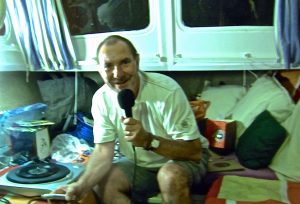
And I went to all this effort so that I could play some Nilsson songs without needing any permission from a producer. This was my station and I could play what I liked. But it was all such a blur I can’t remember what I played.
CHAPTER ELEVEN … BECOMING AN AUTHOR
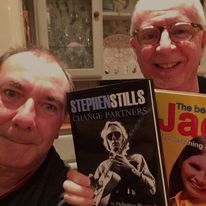
My life took a new and exciting direction when I met local author David Roberts who had written several music books.
We immediately got on well, chatting about music we admired by The Beatles, CSN&Y, James Taylor, Joni Mitchell, Jackson Browne, Bruce Springsteen, among many more. Of course I talked about my obsession with Harry Nilsson.
I also mentioned how much I liked writing.
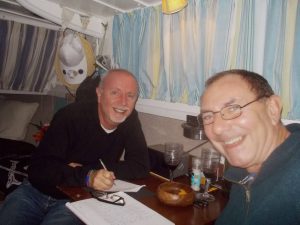
David offered to mentor me and suggested I come up with a few ideas for a book. Possibly something about Harry Nilsson, I wondered?
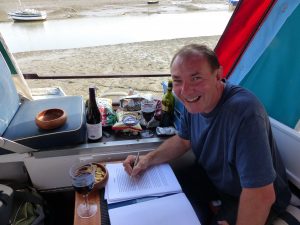
I also had an idea to write about the true story of someone I’d recently met. The man, ‘Leslie Markland’ had been cut out from inheriting his late father’s estate because he had no children to continue the family line, in favour of his younger brother who did have a son. Leslie tries to father a child with a surrogate mother in order to scupper his late father’s final wishes.
David liked the storyline and suggested I submit a chapter each week, and then we would meet on my boat and chat about my words over a bottle of wine and shared food.
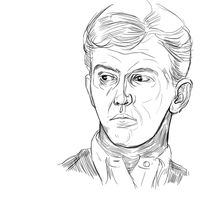 That began our regular ‘Book Club’ that still goes on every Wednesday. As the book progressed, he suggested the title ‘MUDDY WATER‘ referencing the murkiness of the Markland family, as well as the literal muddy water of the Wivenhoe river estuary of the story’s location.
That began our regular ‘Book Club’ that still goes on every Wednesday. As the book progressed, he suggested the title ‘MUDDY WATER‘ referencing the murkiness of the Markland family, as well as the literal muddy water of the Wivenhoe river estuary of the story’s location.
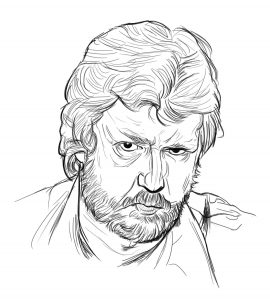 I found myself including as many Nilsson references as I could in the tale, and thanks to my daughter Laura, a talented artist, she interpreted my descriptions of the story’s characters. The young and old Leslie Markland would, of course, have to take on the appearance of the young and old Harry Nilsson. It would be my own private and subtle nod to my hero.
I found myself including as many Nilsson references as I could in the tale, and thanks to my daughter Laura, a talented artist, she interpreted my descriptions of the story’s characters. The young and old Leslie Markland would, of course, have to take on the appearance of the young and old Harry Nilsson. It would be my own private and subtle nod to my hero.
Once I’d reached Muddy Water‘s final full-stop, David and I celebrated with a rather pleasant bottle of Merlot on the boat, and that was when I got my biggest and luckiest break, when he announced that he’d been forming a new publishing company, Hornet Books, and that Muddy Water would be their first title to be released, if I wanted.
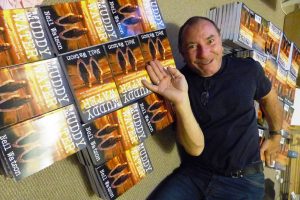
The only condition was that David would design the cover. “Of course!” I said. “Where do I sign?”
And that was how I got my debut novel published and onto Amazon.
CHAPTER TWELVE … RADIO GAGA
I discovered what it was like to be on Cloud Nine when we launched Muddy Water. It couldn’t have gone any better, with the hall crammed with people (some of whom had paid to be in the CASH FOR CHARACTERS scheme), all queuing up to buy their copy. Even Fred Smith (Sam’s dad) turned up, bringing me an LP signed by his famous son.

“Neil, A big thank you. Sam,” was inscribed on it.
I also had my lovely musician friend, Joanna Eden (Sam’s tutor), performing her song Muddy Water that she had written especially for me. How cool was that?
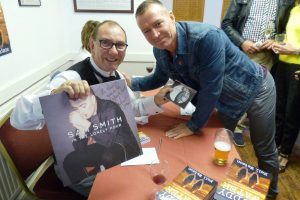 Now with a real paperback book with my name to it, I had to get out there and promote it, and that meant going on the radio.
Now with a real paperback book with my name to it, I had to get out there and promote it, and that meant going on the radio.
Publisher David had organised some interviews, including BBC Essex’s Tony Fisher, and BBC Suffolk’s Stephen Foster.
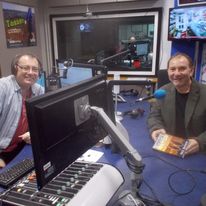 To ease my initial nerves, I found myself talking about the Nilsson connections within the book, and as luck would have it, both Tony and Stephen were also Harry-fans, so they happily concluded my time on air with some Nilsson music.
To ease my initial nerves, I found myself talking about the Nilsson connections within the book, and as luck would have it, both Tony and Stephen were also Harry-fans, so they happily concluded my time on air with some Nilsson music.
Despite my anxiety, I loved being on the radio – and it was certainly more professional at the BBC than on my boat.
David Roberts had also come into contact with another BBC presenter, Mark Punter, who hosted his ‘Vintage Vinyl Show’ on Sunday afternoons, and David had mentioned to him about my love of Nilsson’s music. Mark was also a fan, and invited me to talk all-things-Harry, and choose three songs and explain why.
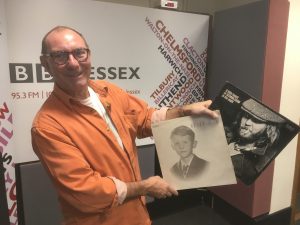
What an opportunity! A date was set for me to go to the station, but it was impossible to prepare only three songs. I decided to take my entire collection of Nilsson LPs and pick the songs at the last minute.
A few weeks earlier I’d met a friend of session musician Herbie Flowers (now sadly passed in 2024).
Herbie had written the No. 1 hit Grandad for Clive Dunn, but he was better known for providing the bass on Lou Reed’s Walk On The Wild Side. I also knew that he’d played on ‘Nilsson Schmilsson’, Harry’s most commercially successful album.

I was keen to ask Herbie if he had any recollections of playing on Schmilsson, and I was given his home number.
He told me how, during the recording of the 7-minute Jump Into The Fire, he began detuning his instrument during the drum solo because he felt it was “going on a bit.”
So, that was one of my chosen tracks, and why.
CHAPTER THIRTEEN … SISTER’S SECRET
I cast my mind back to around 1985 when my sister Emma and her boyfriend Dominic came for dinner. I was pleased to be introduced to Dominic, and as we sat around after we’d finished eating, our topic of conversation turned inevitably to the music that we liked.
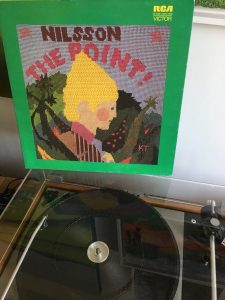
From the dining table I could reach across to my collection of LPs, and I pulled out one of my favourites, Nilsson’s The Point. Dominic declared that he loved it too, but it wasn’t his favourite of all Harry’s albums. I was intrigued. Usually when I mentioned ‘Harry Nilsson’ to someone, the response would be “Harry who?” But not this time.
“Oh, you know Nilsson?” I asked, impressed with Dominic’s knowledge of my music hero. “Yes, of course I do. Harry’s my Godfather,” he said, nonchalantly.
“What?” I asked, astounded.
“Yes. And my other Godfather is George,” Dominic elaborated, referring of course to George Harrison. I almost fell off my chair.
Emma had never told me that her boyfriend was the son of Derek Taylor, the Beatles’ press officer, who was known famously (among Nilsson fans like myself) to have been instrumental in bringing Nilsson to the attention of the Beatles in the late ’60s. In the early ’70s he also produced one of Nilsson’s albums A Little Touch of Schmilsson in the Night.
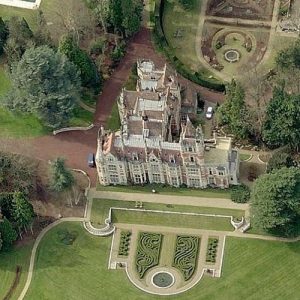
And then when Emma, a trained Cordon Blue chef, went on casually to explain that she’d been to Harrison’s gothic house, Friar Park, on a few occasions to do the party catering there, I think I actually did drop to the floor.
If only she’d told me. I’d have happily driven her there at any time and waited by the gates all evening if I’d had to. I’ve never really forgiven her for keeping her cards so closely guarded during that time.
CHAPTER FOURTEEN … ‘HARRY & ME’
In 2021 David Roberts and I began working on ‘Harry & Me’.
The concept was simple; Harry Nilsson’s life would be told in the words of his friends, family members, fellow musicians and fans.
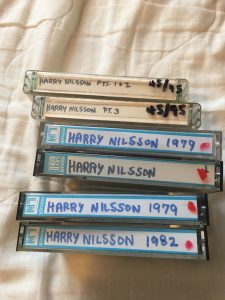
BUT… Zak Nilsson, Harry’s eldest son was succumbing to cancer, and I really wanted his approval for the book before we began. Fortunately he did approve, and so the project was born with us making contact with anyone we could think of who knew or loved Harry.
And then there were the tapes. Every now and then I would check out eBay in case there was anything special, Nilsson-related. On one such occasion there was a package of exclusive audio cassettes of interviews with Harry that had been kept in storage for many years. Without hesitation I knew I had to have them and I negotiated with the seller, ‘The Jewish Rapper’ from Los Angeles.
Harry talking about his life, his friendship with John Lennon, his house, his recordings, and all number of subjects was absolutely incredible, and I painstakingly transcribed them for inclusion in the book.
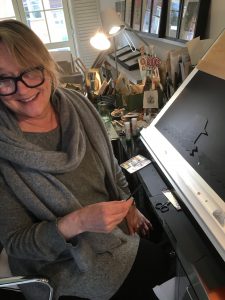 The cover was created by artist Alison Stockmarr from a montage of images synonymous with Nilsson, and we included a CD of some of Harry’s interviews.
The cover was created by artist Alison Stockmarr from a montage of images synonymous with Nilsson, and we included a CD of some of Harry’s interviews.
I began my Nilsson adventure in my early teens, and it culminated 50 years later with a book that I’m very proud to have co-authored.

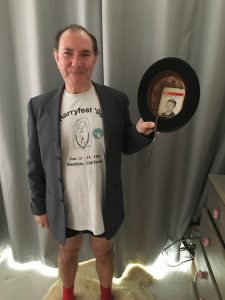 I thought it was all over… but there was more to come!
I thought it was all over… but there was more to come!
Two years after publication I returned to Los Angeles to meet some of the folks who contributed to the book.
That was a thrill in itself, but the greatest delight and honour was to be invited to Una’s house for tea. Una Nilsson, Harry’s widow, and their daughter Olivia greeted me at her beautiful California house, where we sat at her table and drank tea from her grandmother’s tea-pot, and chatted about Harry and the book I’d written about him. I promised I would never show the photographs I took of Una, and I’m a man of my word, but I know Olivia is keen to promote her late father’s legacy – so here I am with her, and the perfectly laid table.


